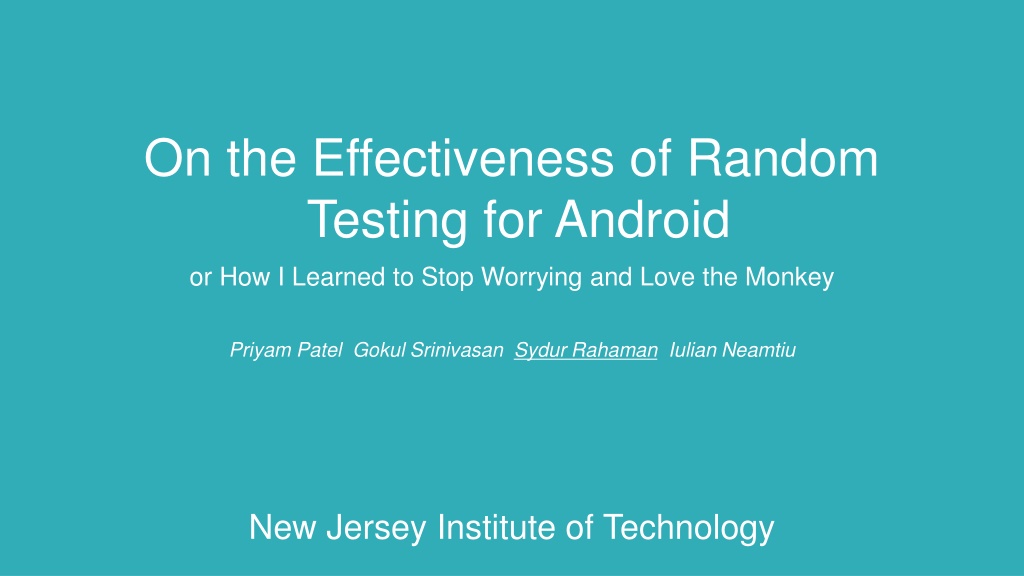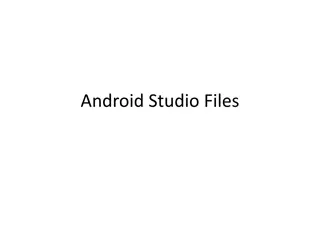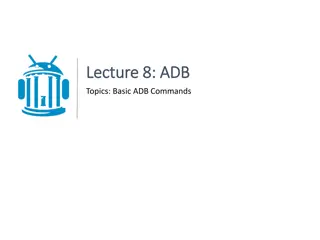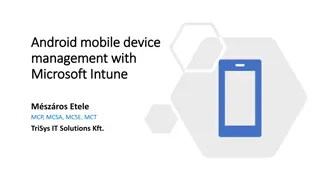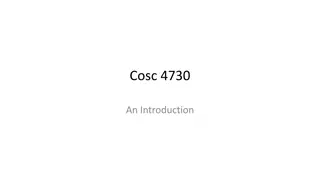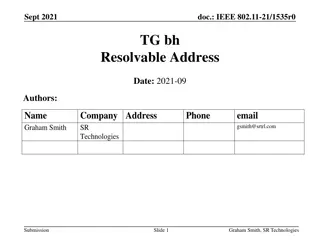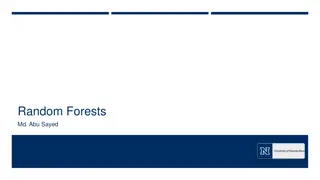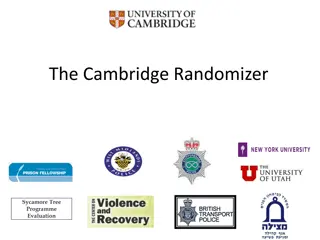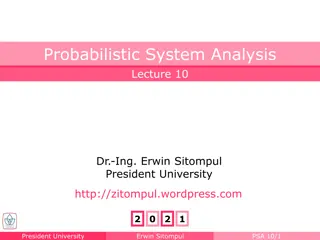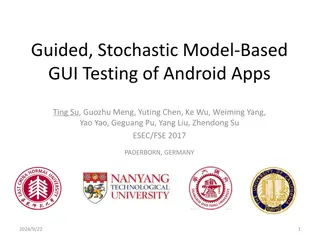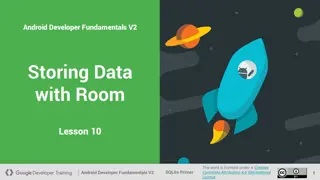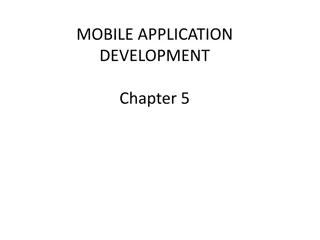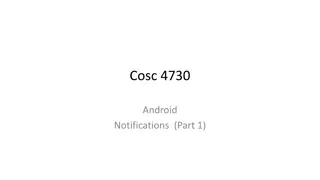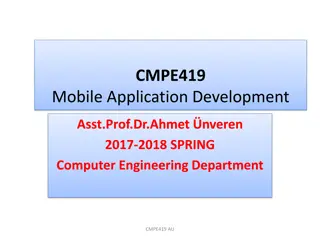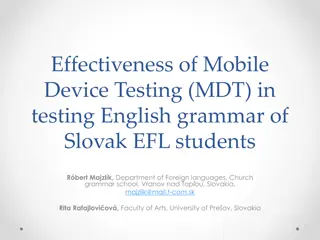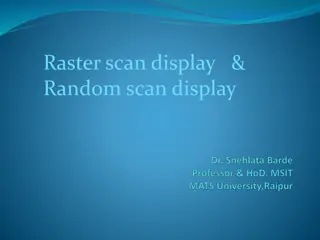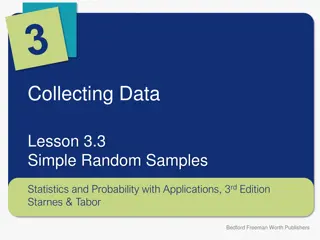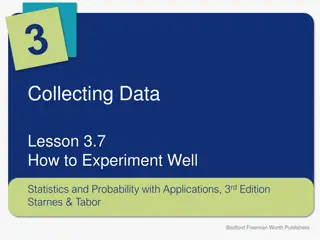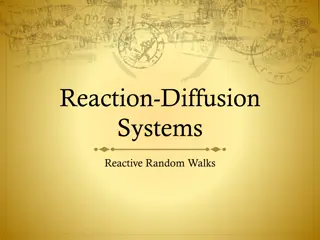The Effectiveness of Random Testing for Android
The study explores the effectiveness of random testing tools for Android applications, with Monkey showing the highest coverage level among various tools tested. Monkey's event distribution and inquiries regarding its strategies and coverage analysis are detailed, affirming its effectiveness in stress-testing and generating random events. The research aims to optimize Monkey's performance for better coverage and app stability in the dynamic Android ecosystem.
Download Presentation

Please find below an Image/Link to download the presentation.
The content on the website is provided AS IS for your information and personal use only. It may not be sold, licensed, or shared on other websites without obtaining consent from the author. Download presentation by click this link. If you encounter any issues during the download, it is possible that the publisher has removed the file from their server.
E N D
Presentation Transcript
On the Effectiveness of Random Testing for Android or How I Learned to Stop Worrying and Love the Monkey Priyam Patel Gokul Srinivasan Sydur Rahaman Iulian Neamtiu New Jersey Institute of Technology
Motivation Android runs on 85% of smartphones globally More than 2 billion monthly active devices Google Play, the main Android app store, offers more than 3 million apps Android apps are updated on average every 60 days Testing all these releases requires scalable, easy-to-use, portable, and effective tools
Monkey Beat All Android Testing Tools Monkey Dynodroid ACTEve PUMA GUIRipper A3E (our own prior work) A prior study has compared the coverage attained by all those tools on 64 apps has shown that, on average, Monkey manages to achieve the highest coverage level across all the tools 0 2 S. Choudhary, A. Gorla, A. Orso. "Automated Test Input Generation for Android: Are We There Yet?" (ASE'15)
What is Monkey? Monkey s Default Events Distribution Event Description Frequency (%) single touch (screen press & release) 15 TOUCH Open source random testing tool 10 MOTION drag (press, move, release) sequence of small moves, followed by an optional single click 15 TRACKBALL Runnable in physical device or emulator keyboard up/down/left/right 25 NAV menu button, keyboard center button 15 MAJORNAV Generates and injects random events SYSOPS 2 system keys, e.g., Home, B ack, Call, End Call, Volume Up, Volume Down, Mute Watches for app crashing, exceptions throwing Switch to a different app APPSWITCH 2 Flip open keyboard FLIP 1 Any event ANYTHING 13 Pinch or zoom gestures PINCHZOOM 2
Our Inquiries Is stress-testing with Monkey an effective strategy for crashing apps? Can manual exploration lead to higher coverage than Monkey s? 1 4 Can Monkey be more effective (yielding higher coverage) when appropriately tuned ? Does inter-event time (throttling) affect coverage? 2 5 Is coarse-grained (e.g., class/method) coverage indicative of fine-grained (e.g., block/line) coverage? 3
Question 1 Q: Is stress-testing with Monkey an effective strategy for crashing apps? Answer: Yes
APP Installs (millions) #Events Time to crash (sec) Shazam 100-500 1,270 36 Application Crashes Spotify 100-500 9,011 83 Facebook 1,000-5,000 9,047 197 Whatsapp 1,000-5,000 14,768 175 Splitwise 1-5 819 12 UC Browser 100-500 5,575 51 NY Times 10-50 24,358 329 Instagram 1,000-5,000 279 7 Snapchat 500-1,000 4,676 24 Walmart 10-50 6,510 56 MX Player 100-500 1,742 41 Evernote 100-500 8,733 91 Skype 500-1,000 17,435 95 Waze 100-500 7,261 38 Google 1,000-5,000 1,220 34 Mean 7,513 85
Question 2 Q: Can Monkey be more effective (yield higher coverage) when appropriately tuned ? Answer: No
Biasing Input Distribution Coverage Yahtzee Wikipedia Touch (75%) TippyTipper Default Touch (75%) LearnMusicNotes ImportContacts 0 50 100 Biasing leading to higher class coverage for some isolated cases only
Biasing Input Distribution Mean across 64 apps Coverage Type Mean Default Touch (75%) Motion (75%) Trackball (75% ) Nav (75%) Major Nav (75%) 49.3 49.9 47.1 48.0 48.5 50.7 Class Method Block Line 39.7 39.8 36.5 38.1 39.2 40.8 35.7 36.4 32.5 34.1 35.6 36.9 35.5 35.1 32.0 33.7 35.0 36.7 Biasing mild decrease in coverage for all types (class, method, block, and line) only isolated/insignificant increases
Question 3 Q: Is coarse-grained (e.g., class/method) coverage indicative of fine-grained (e.g., block/line) coverage? Answer: Yes
Pairwise Correlation Correlation Between Coverage Types: Class (C), Method (M), Block (B), and Line (L) Touch Motion Trackball Navigation Major Nav M B L M B L M B L M B L M B L C 0.93 0.91 0.92 0.95 0.78 0.82 0.97 0.94 0.96 0.98 0.96 0.96 0.97 0.93 0.95 M - 0.96 0.97 - 0.93 0.94 - 0.97 0.98 - 0.99 0.99 - 0.95 0.97 B - - 0.99 - - 0.99 - - 0.99 - - - - 0.99 Most correlation values > 0.9 This suggests a pragmatic approach for measuring coverage: low-overhead, coarse-grained coverage (class/method) is an accurate indicator of high-overhead, fine-grained coverage (block/line)
Question 4 Q: Within a 5-minute exploration time, does manual exploration achieve higher coverage than Monkey? Answer: Yes
Manual vs. Monkey Coverage Mean coverage across 64 apps Coverage Coverage Type Mean aLogCat Monkey Manual Bites K-9 mail Class 52.4 54.7 Multi SMS MunchLife Method 42.2 45.0 Manual Monkey Netcounter Photostream Block 38.6 42.5 Weight-chart Line 38.1 41.6 0 50 100 While manual exploration could be considered a "golden standard" at exploring an app thoroughly, we found that it might not to be the case for all apps
Question 5 Q: Does inter-event time (throttling) affect coverage? Answer: No
Varying Throttle Line Coverage 80 Mean coverage across 64 apps 70 Throttle (msec) Coverage 60 50 0 (Default) 40.8 40 0 ms 100 ms 200 ms 600 ms 100 45.0 30 200 42.5 20 600 42.6 10 0 Throttle does not affect coverage significantly
Conclusions Despite its simplicity, random testing for Android is effective Reveals stress-related crashes Coverage on par with laborious approaches such as manual exploration Monkey's default event type distribution and settings are appropriate for achieving high coverage in a wide range of apps Coarse-grained, class/method coverage is effective Low-overhead, but indicative of finer-grained, block or line coverage
